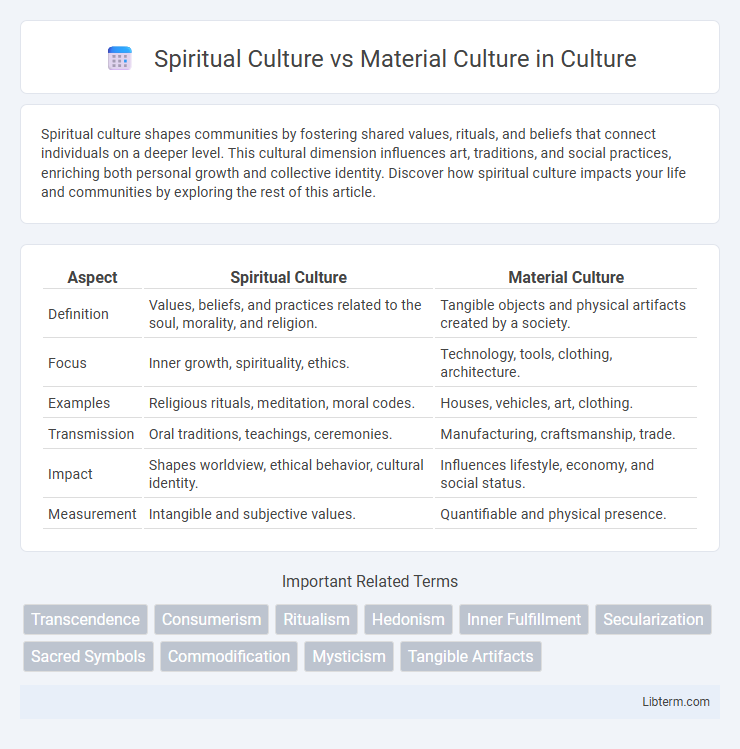Spiritual culture shapes communities by fostering shared values, rituals, and beliefs that connect individuals on a deeper level. This cultural dimension influences art, traditions, and social practices, enriching both personal growth and collective identity. Discover how spiritual culture impacts your life and communities by exploring the rest of this article.
Table of Comparison
| Aspect | Spiritual Culture | Material Culture |
|---|---|---|
| Definition | Values, beliefs, and practices related to the soul, morality, and religion. | Tangible objects and physical artifacts created by a society. |
| Focus | Inner growth, spirituality, ethics. | Technology, tools, clothing, architecture. |
| Examples | Religious rituals, meditation, moral codes. | Houses, vehicles, art, clothing. |
| Transmission | Oral traditions, teachings, ceremonies. | Manufacturing, craftsmanship, trade. |
| Impact | Shapes worldview, ethical behavior, cultural identity. | Influences lifestyle, economy, and social status. |
| Measurement | Intangible and subjective values. | Quantifiable and physical presence. |
Defining Spiritual Culture and Material Culture
Spiritual culture encompasses beliefs, values, rituals, and practices that reflect a community's metaphysical understanding and connection to the sacred or transcendental. Material culture involves tangible objects, artifacts, architecture, and technology created and utilized by a society, serving as physical manifestations of cultural identity. Both dimensions are essential for comprehending the full scope of human cultural expression and social development.
Historical Roots of Spiritual and Material Values
Spiritual culture originates from ancient religious beliefs and philosophical traditions that emphasize intangible values such as morality, faith, and inner peace, shaping societies' ethical frameworks for millennia. Material culture, rooted in the development of agriculture, craftsmanship, and trade since prehistoric times, centers on physical artifacts, technologies, and wealth accumulation reflecting human interaction with the environment. Historical evidence from civilizations like Mesopotamia and Ancient Egypt highlights the coexistence and tension between spiritual values upheld by priestly classes and material wealth controlled by ruling elites.
Core Beliefs: Spiritualism vs. Materialism
Core beliefs in spiritual culture emphasize metaphysical values, inner growth, and the interconnectedness of all beings, rooted in spiritualism and often expressed through rituals, meditation, and ethical living. Material culture centers on physical objects, economic wealth, and tangible achievements, reflecting materialism's focus on external success and sensory experiences. The contrast lies in spiritualism prioritizing transcendental meaning over material possession, while materialism values the accumulation and utilization of physical resources.
Cultural Practices and Daily Life
Spiritual culture shapes daily life through rituals, ceremonies, and belief systems that influence values, social behavior, and community cohesion. Material culture manifests in tangible objects such as tools, clothing, and architecture that support everyday activities and practical needs. Both cultural practices intertwine to create a holistic lifestyle, where spiritual beliefs guide the use and significance of material artifacts.
The Role of Religion and Philosophy
Religion shapes spiritual culture by providing moral frameworks, rituals, and symbols that influence values, identity, and social cohesion. Philosophy contributes to spiritual culture through critical thinking, ethical theories, and existential inquiries that guide individual and collective understanding of life's purpose. Material culture is often a manifestation of these spiritual beliefs, with religious artifacts and philosophical symbols reflecting deeper intangible concepts.
Impact on Social Relationships and Communities
Spiritual culture fosters deep interpersonal connections through shared beliefs, rituals, and values that promote empathy, cooperation, and collective identity within communities. Material culture emphasizes tangible objects and economic interactions, shaping social relationships around consumption patterns, status symbols, and resource distribution. The interplay between spiritual and material culture influences community cohesion by balancing intangible cultural bonds with practical social needs.
Consumerism and the Pursuit of Meaning
Consumerism, a central element of material culture, prioritizes the acquisition of goods and services as a path to satisfaction, often leading to short-term gratification without deeper fulfillment. In contrast, spiritual culture emphasizes the pursuit of meaning, inner growth, and connection beyond physical possessions, fostering long-lasting contentment. The tension between these cultures highlights the challenge of balancing material wealth with meaningful experiences in contemporary society.
Education: Teaching Spiritual and Material Values
Education plays a pivotal role in transmitting both spiritual and material values, shaping individuals' worldviews and ethical frameworks. Spiritual culture in education emphasizes inner development, moral integrity, and connectedness, encouraging empathy, mindfulness, and a sense of purpose. Material culture in education focuses on practical skills, technological knowledge, and economic competencies essential for navigating and contributing to the modern world.
Challenges in Balancing Spirit and Matter
Challenges in balancing spiritual culture and material culture arise from the inherent tension between intangible values such as beliefs, ethics, and inner fulfillment, and tangible pursuits like wealth accumulation, technological advancement, and consumerism. The dominance of material culture often leads to the marginalization of spiritual practices, resulting in societal stress, alienation, and a loss of deeper meaning. Achieving equilibrium demands intentional cultural frameworks that integrate spiritual well-being with material progress to foster holistic human development.
The Future of Cultural Identity
The future of cultural identity increasingly hinges on the dynamic interplay between spiritual culture and material culture, where intangible beliefs and values shape societal cohesion more profoundly than physical artifacts. Advancements in digital technology and globalization amplify the transmission of spiritual practices, reinforcing identity beyond geographical constraints. Preserving spiritual culture within an evolving material world ensures that cultural identity remains resilient, adaptive, and meaningful in a rapidly changing global landscape.
Spiritual Culture Infographic

 libterm.com
libterm.com